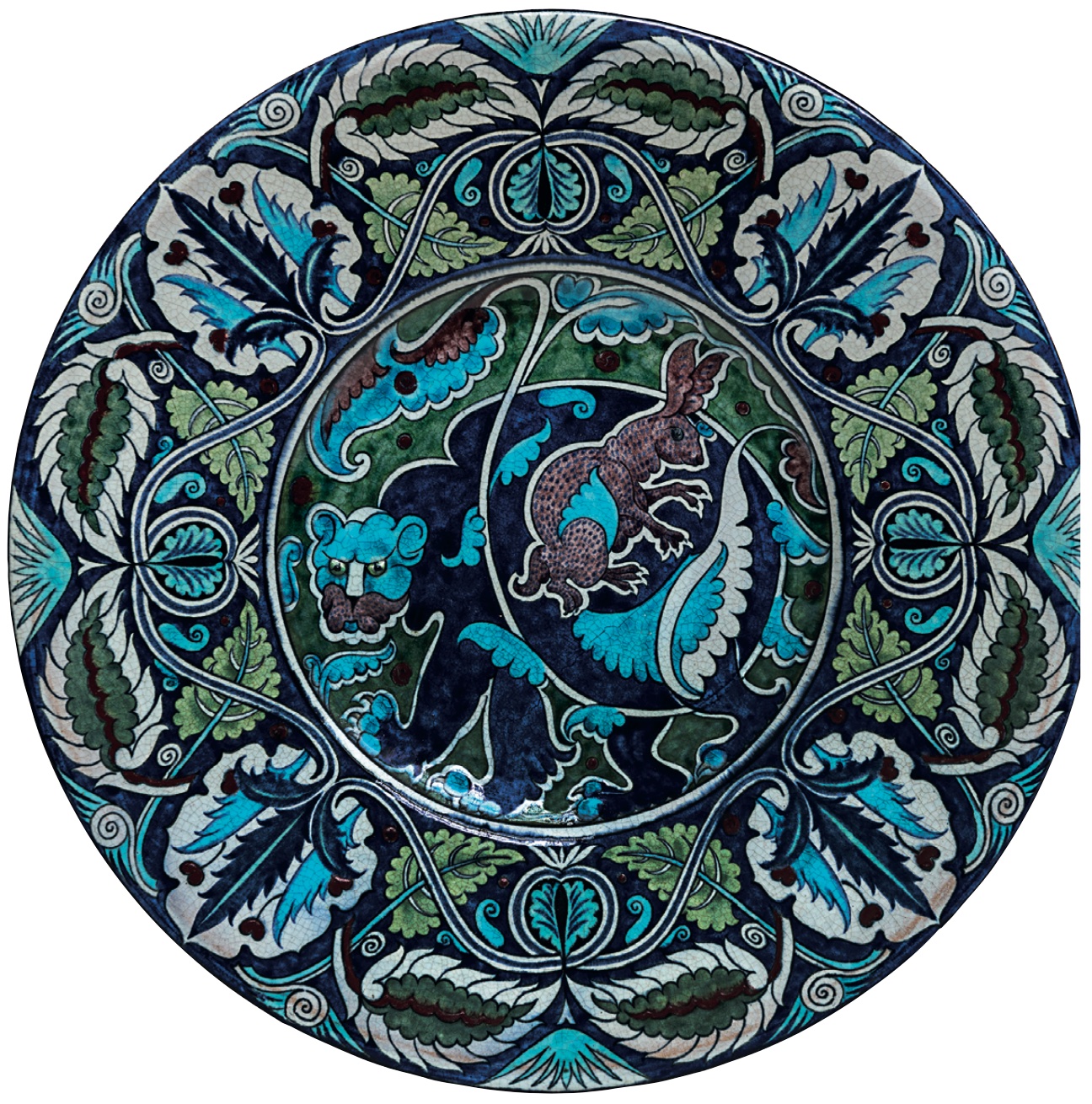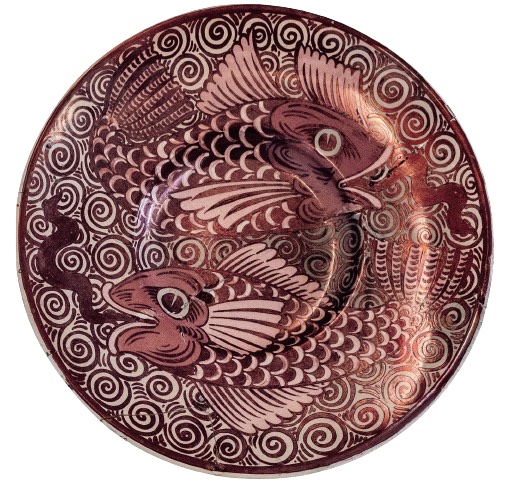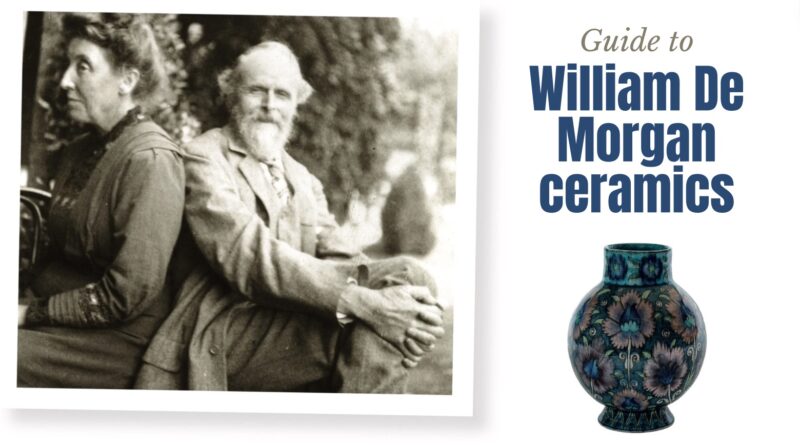William De Morgan – the ultimate guide
William De Morgan Ceramics
With their bright colours and fabulous designs, the ceramics of William De Morgan (1839-1917) are among the most recognisable and enduringly popular decorative arts of the late Victorian period.
The boundaries of his imagination were seemingly endless, from the technical (he singlehandedly revived the ancient glaze of lustre ware) to the lyrical (he went on to author seven popular novels). The scope of his designs ranged from Pre-Raphaelite medievalism and Italian Renaissance majolica to ancient Middle Eastern motifs. An ongoing exhibition at Blackwell, the Arts and Crafts House, in Bowness-on- Windermere in Cumbria, this month showcases De Morgan’s many talents focusing on symmetry, pattern and shape.

Liberal background
Born in London’s Gower Street in 1839, William Frend De Morgan was the son of the distinguished mathematician Augustus De Morgan and his wife Sophia Elizabeth Frend, a highly educated woman who was an advocate for women’s higher education and an early supporter of the suffragette movement.
Being born into a liberal middle class family no doubt made it easier for him to follow his heart and, when it came to his education, at the age of 20 he entered the Royal Academy schools. This proved presumably not entirely satisfactory, judging from the fact he left with four years to go. The young De Morgan then showed a distinct uncertainty as to the direction of his career and he dabbled more or less successfully in various pursuits. His circle of friends included Edward Burne-Jones, Dante Gabriel Rossetti, Philip Webb, and, perhaps most importantly, William Morris. Apart from introducing De Morgan to the applied arts in general, Morris also brought him into the centre of the arts and crafts movement.

William Morris
From the 1860s onwards, stained glass enjoyed a major revival as Morris and his contemporaries re-popularised the arts of the medieval period, providing stained glass windows for both church restorations and domestic buildings. Having tried and dismissed traditional painting he turned to stained glass and the painting of some of Philip Webb’s furniture. Although De Morgan soon distanced himself from Morris’ dogmatic and sometimes utopian viewpoint of the arts and crafts movement and of his own production within it, this period was nevertheless of utmost importance to the development of his interest in pottery. An interest that led to one of the most prolific and exciting periods of ceramics production of the Victorian era spanning 35 years.
It seems to have been De Morgan’s work with stained glass that ultimately kindled his interest in pottery by introducing him to lustre glazes and their complex chemistry. De Morgan found himself experimenting with various glaze components and firing techniques which he tested on blank tiles. This coincided with a boom in decorative tiles in the late 19th century.

Commercial tile making
De Morgan began to experiment with tile decoration in his studio at London’s Fitzroy Square. There were a number of tile manufacturers at the time, including Minton’s and Maw & Co., as well as several outlets where tiles were sold. One of these of course being William Morris’ own Morris & Co.
So De Morgan entered the world of commercial tile making. Initially his designs owed much to Morris and mainly featured flowers and leaves, often done so they could form an infinite pattern for use in friezes and fireplaces. However, his imagination set him off in a direction of ever expanding ideas to the point when he felt confident enough to start a business on his own.
De Morgan’s first proper kiln was set up at 30 Cheyne Row in Chelsea where firing could be conducted safely in a shed in the back garden. The roof of his previous lodgings had been burnt down due to his firing experiments, making him perhaps not the most popular tenant. He stayed in Cheyne Row for 10 years even expanding up the road to number 36 were he arranged both a workshop and showroom for his growing clientele. It is from this Chelsea period that the majority of his tile designs originate.

Popular designs
The arts and crafts ideology he was exposed to through his friendship with Morris and his own insistent curiosity, led De Morgan to begin to explore every technical aspect of his craft. As well as an abundance of floral patterns he increasingly made use of birds and animals as well as mythical beasts. The tiles themselves, as well as 14in rice dishes, were initially bought as blanks from factories like Wedgwood. Later De Morgan would go on to produce his own pottery.
De Morgan cleverly creating intricate repeating patterns which could be used to great effect. Some of his early designs from this period became hugely popular and were in production for almost 30 years, such as Bedford Park Daisy and BBB – named after the Norwich ironmonger Barnard, Bishop and Barnard, who sold the tiles as part of their cast-iron fireplaces. His inventive streak lured him into complex studies of the chemistry of glazes, methods of firing, and pattern transfer.
Middle East
Towards the latter part of the 1870s, De Morgan became more aware of the fantastic inspiration from the Middle East. The South Kensington Museum (now the V&A) had a good collection of Islamic pieces, including pottery which both De Morgan and Morris studied with great interest.
The influence of Middle Eastern designs was not new (Owen Jones had referred to them as early as 1856 in his Grammar of Ornament). But around 1873–1874, De Morgan made a striking breakthrough by rediscovering the
technique of lustre ware (characterised by a reflective, metallic surface) found in Hispano- Moresque pottery and Italian majolica. Nor was his interest in the East limited to glazing techniques, but it permeated his notions of design and colour, as well. As early as 1875, he began to work in earnest with a Persian palette: dark blue, turquoise, manganese purple, green, sealing wax red, and lemon yellow. These ‘Persian’ pieces continued to be produced alongside the lustre ware for the rest of De Morgan’s career.

Move to Merton Abbey
As the business expanded, De Morgan took on partners and assistants. In the 1870s he was joined by the brothers Frederick and Charles Passenger, who were to remain his chief painters and with whom he entered a partnership. At the time he was also joined by Reginald Thompson who, apart from contributing to the design process, is thought to have invested in the pottery. By 1882, De Morgan’s business had outgrown its Chelsea premises and was moved to Surrey. The Merton Abbey site was considerably larger and also closer to William Morris’ textile workshop which had recently opened there. At Merton Abbey De Morgan had the opportunity to design and have built customised kilns to suit his continuing glazing and firing experiments. The expansion also permitted him to manufacture pottery on site rather than buying blanks, consequently he started to design his own pieces and to pay greater attention to the relationship between shape and decoration.
His throwers then manufactured each piece to his specification. The move to self-produced pottery meant that De Morgan was not confined to the tiles and dishes used during the Chelsea period.
In fact not many of the tile designs made during the Merton Abbey period continued. Instead, a wide range
of vases and bowls were produced, many in the Persian colours. The designs from this period tended to be bolder but also more successful with a greater harmony between the pattern and the piece on which it was painted.
Tile revival
The great period of English tilemaking dates to the medieval times when encaustic tiles were used on the flooring of cathedrals and monastic buildings. But almost all tilemaking ended with the Reformation with many tiled floors boarded over.
Tiles came back into vogue in a modest way in the 1830s as part of the general revival in church building. In the 1840s A.W.N. Pugin introduced colour-printed tiles in his decoration of the smoking room of the new House of Commons.
By the 1860s Victorian interiors offered a multitude of options for decorative tiles from hallways to new ‘modern’ bathrooms and kitchens. Domestic coal-burning grates was an ever- growing industry through the 19th century with the earlier metal grates replaced in the later half of the century with tiles. Industrial developments also made possible the production of tiles in numbers.
Marriage to Evelyn
Unfortunately, De Morgan suffered from ill health and by the mid 1880s found it increasingly tiring to commute to Surrey. In 1888, he opened a studio closer to home in Sands End, Fulham.

The pottery was beset by financial problems, despite repeated cash injections from his wife, the pre-Raphaelite painter Evelyn De Morgan (née Pickering) whom he married in 1887. Here he was joined by a new partner the architect Halsey Ricardo, with whom he worked on several large projects including Peacock House as well as important commissions for a series of tile patterns for P&O Line.
The Fulham period is considered De Morgan’s best and is certainly the most prolific. He mastered many
of the technical aspects of his work that had previously been elusive, including complex lustres and deep, intense underglaze painting that did not run during firing.
One of the best-known portraits of De Morgan painted by his wife Evelyn, shows him holding a stunning lustre vase widely acknowledged to be his crowning triumph. In 1919 the vase was bequeathed by Evelyn to the V&A.
Pots to books
However the period was also marred with increasing problems. De Morgan’s health continued to decline
and, to relieve his symptoms, he opted to spend the winter months in Florence. This naturally put increasing pressure on Ricardo even though De Morgan did his best to supervise output and provide ready-to-use patterns from Italy.
It was an inefficient system and the business began to suffer, Ricardo left and De Morgan entered into a partnership with the Passenger brothers and his kiln master Frank Iles. This was to last until 1907 when De Morgan withdrew from the business.
Late in life he turned his hand to writing novels, and became better known for these than he ever had been for his pottery. His first novel, Joseph Vance, was published in 1906, and was an instant sensation in both the UK and US. This was followed by An Affair of Dishonour, Alice-for- Short and It Never Can Happen Again. He died in 1917 and was buried in Brookwood Cemetery.
William De Morgan marks

Although far from all De Morgan’s pottery is marked, there is a range of markings that can help to date it. Some pieces, although not bearing a De Morgan mark, have the initials of one of the Passenger brothers, this normally indicates a well painted piece, thus serving as a quality control measure. Other initials include J.J. for Joe Juster, H.R. for Halsey Ricardo and E.P. for Edward Porter.
As with all hand-crafted items there are varying degrees of quality in De Morgan’s pottery. Due to the sensitivity of the glaze components
and the unreliability of the firing process some pieces look crisp and well defined whereas on others the glaze may have run or misfired.
The lustre pieces are the most sensitive to firing temperatures and pieces can come out too dark or lacking in definition.
Technical know-how
Several techniques were used to apply designs to tiles and vessels, the three main being pouncing, the painted paper technique and painting straight onto the ware. Pouncing was a fairly lengthy process. The finished design was copied onto tracing paper, after which the outline was pierced with tiny pin pricks. The paper was then placed on slip-coated ware and dusted with a fine powder. The powder penetrated the tiny holes and, when the paper was lifted, the pattern was left on the ware, ready to be filled with coloured pigments.

The painted paper technique was more economical and tended to be used for tiles which needed to be produced in large numbers. Again the design was copied onto tracing paper, this time in thick ink outlines.
The copied design was fixed to a sheet of glass which then served as the master copy. On the other side of the glass another sheet of paper was fixed and, by lighting the glass behind, the master copy would shine through and provide the outline within which the painter could then apply the colour pigments.
This painted sheet was then placed face down on the skip-coated ware and fixed with sodium silicate after which it was sprinkled with powdered glaze. It was then fired during which the paper burnt away and the pigments fused with the glaze, thus transferring the pattern to the ware.
The drawback of the printed paper technique was that it could only be used on flat surfaces. On vases and bowls the designs had to be transferred either by pouncing or painting directly onto the ware, with the latter supervised by De Morgan.
Featuring some 60 tiles and vases from the De Morgan Collection and pieces from the Lakeland Arts collection, Sublime Symmetry: William De Morgan is on at Blackwell, the Arts & Crafts House, Bowness-on- Windermere, Cumbria, LA23 3JT until October 6. For more details go to www.blackwell.org.uk


